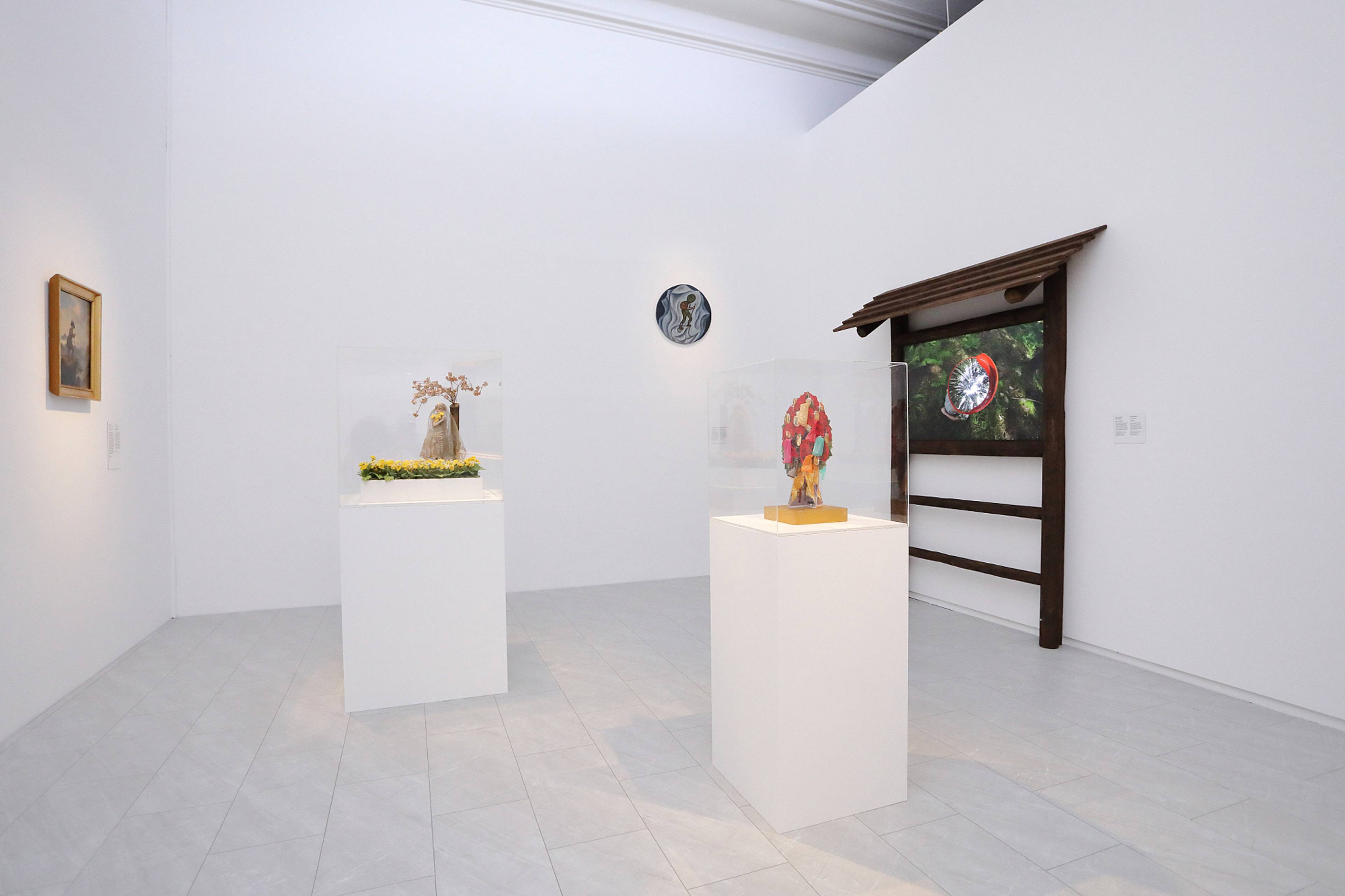Two works to illustrate the themes in this steirischer herbst: A graying performer stands on stage, somewhat raggedly dressed in a a colorful, flowing shirt. Accompanied by a drummer and a keyboard player, Augustin Maurs’s hour-long musical program begins in variety-show style, interpreting the favorite songs of dictators and potentates around the globe: Slobodan Milošević (Frank Sinatra, “My Way,” 1969), Kim Jong Un (Modern Talking, “Brother Louie,” 1986), and Vladimir Putin (Fats Domino, “Blueberry Hill,” 1956). This list goes as far as Jean-Marie Le Pen, founder of France’s far-right Front National, who ran a record label that featured such obscure recordings as “Algerian War,” Vol. 1–4 and the collected speeches of Adolf Hitler. It’s difficult to say what holds these songs together, but that they’re all performed by men. Maurs’s is a very reduced and cool performance, satire in the best sense of the word – and the laughter gets stuck in your throat.
Second is a pair of videos by Alina Kleytman in the Neue Galerie Graz. In Tongue (2020), the artist lies on a hospital bed, seemingly without suffering or injury, until her tongue begins to swell, slowly and inexorably, to a grotesque size. Close to vomiting, it is language that threatens to suffocate Kleytman – a Ukrainian speaking in Russian. The Place to See Before You Die (2024), meanwhile, is a cynical examination of the invasion of Ukraine, in which the author roams through bombed-out buildings in Kharkiv as a dirty, white, mythical creature and markets them as luxury-horror vacation apartments.
Still from Jan Peter Hammer, Noreia, 2024, 4K, color, stereo, 60 min. Courtesy: the artist
Roee Rosen, works from the “Gaza War Tattoos,” 2024. Installation view, Neue Galerie Graz. Courtesy: Universalmuseum Joanneum. Photo: J.J. Kucek
“Horror Patriae”(The Horror of the Fatherland) titles not only this exhibition, but the greater four week-festival, backdropped by Austria’s far-right party recently winning a plurality of votes in national legislative elections, behind a leader who has openly referred to himself as Volkskanzler (people’s chancellor) – a clear allusion to the Third Reich. It’s not just the political myths and dark nationalisms; this horror is also the back-door penetration of a new conservatism into seemingly left-wing households, per steirischer herbst director Ekaterina Degot. Briefly paraphrased: a romanticized nature, a false nature, a fatherland in which “climate change” is officially outlawed, technoid speech – modernity and internationalism are definitely broken. Our present’s retro discourse demands we put down new roots instead of traveling around cosmopolitically – more localism, less speciesism.
The titles of some lectures and events are ambivalent, but to the point: Do Leftists Have a Home? Is the Local Always Reactionary? Is Peace Ok? The talk The Archeology of Toxic Memories addresses these ambivalences with contributions from Jan Peter Hammer and Roee Rosen. Hammer’s Noreia (2024) centers a village cultishly renamed in 1930 for the supposed discovery that Germanic tribes overran the Roman legions in that part of Styria, mixing re-enactment of that battle and documentary footage of the site in a whimsical film portrait of today’s villagers. Rosen’s photo series “The Gaza War Tattoos” (2024), on the other hand, evokes the Israeli invasion of Gaza by means of “fake” tattoos – of severed limbs, militaristic buzzwords, and other disturbing evocations of very real violence.
Views of “Horror Patriae,” steirischer herbst ’24, Neue Galerie Graz.
Courtesy: Universalmuseum Joanneum. Photo: J.J. Kucek
The Neue Galerie exhibition also engages politically contaminated or otherwise surprising works from the collection of the wider Universalmuseum Joanneum, such as a Nazi chandelier, a map of the province of Styria in the outline of Mars (the god of war), and a photograph of Sigmund Freud’s children in Tracht (traditional costume). Many of the contemporary works hit the theme quite precisely, their rare stringency owing to the fact that almost two thirds of the non-collection works were commissioned by the festival. This is good, because contemporary art can defuse or comment on many things here – but commissioning a certain kind of art to underline one’s own thesis is an equally frightening move. What is that, then? Isn’t the freedom of art at stake?
This is all the more striking in light of the fact that “Horror Patriae” also manages to hit viewers with older works. Its very first room juxtaposes photos of a Tracht-ful urban youth of the 1980s with VALIE EXPORT’s mise-en-scènes of the female self as a patrifamilial prisoner, along with two sculptures by Michèle Pagel, White Trash Bag #1 (Stammhalter) [Firstborn Male Descendent] and #2 (Infantin) [Infanta, both works 2023] – garbage bags filled with concrete, one dressed in suspenders, the other in a corset. Right next to them, an admittedly delightful, fountainish putto by the Nazi-affine Austrian Gustinus Ambrosi, placed in front of Paulina Ołowska’s painting Mokosh and Friends (2023), whose swamp goddesses evoke Slavic folklore and Polish patriarchy. The exhibition expands from local beginnings to include other horror scenarios. Passing Tomislav Gotovac’s Hommage to Glenn Miller (1990), a grotesque performance video about the “Endsieg” of the neoliberal world order over communism, the tour ends with Rosen’s made-up tattoos. The past appears coterminous with the present, equally daunting, hauntingly farcical.
Mid-left: Michèle Pagel, White Trash Bag #1 (Stammhalter) and White Trash Bag #2 (Infantin), both 2023; back-right: Paulina Ołowska, Mokosh and Friends, 2023. Installation view, steirischer herbst ’24, Neue Galerie Graz. Courtesy: Universalmuseum Joanneum. Photo: J.J. Kucek
Still from Tomislav Gotovac, Hommage to Glenn Miller, 1990, video documentation of a performance, 37 min. Courtesy: the artist
___
“Horror Patriae”: steirischer herbst 2024
Various venues, Graz
20 Sep 2024 – 16 Feb 2025








